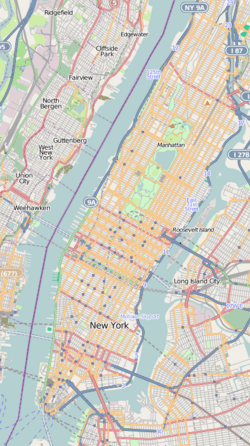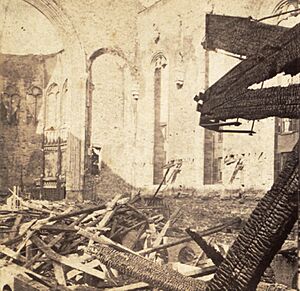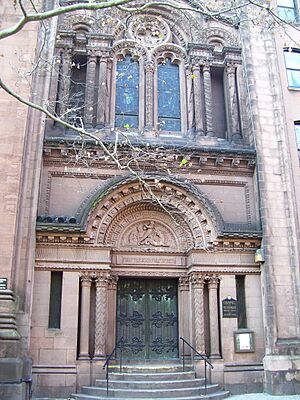St. George's Episcopal Church (Manhattan) facts for kids
|
St. George's Episcopal Church
|
|
 |
|
| Location | 209 East 16th Street, Manhattan, New York City, New York |
|---|---|
| Built | 1846–1856 |
| Architect | exterior: Otto Blesch interior: Leopold Eidlitz |
| Architectural style | Romanesque Revival |
| NRHP reference No. | 76001249 |
Quick facts for kids Significant dates |
|
| Added to NRHP | December 8, 1976 |
| Designated NHL | December 8, 1976 |
St. George's Episcopal Church is a very old and important church in New York City. You can find it at 209 East 16th Street on Stuyvesant Square in Manhattan. It is known as one of the first and best examples of early Romanesque Revival church style in America. Charles Otto Blesch designed the outside of the church. The inside was designed by Leopold Eidlitz. Today, it is one of the two main churches of the Calvary-St. George's Parish.
Contents
History of St. George's Church
The first St. George's was a small church built in 1752. It was created by Trinity Church for people living on the east side of Lower Manhattan. That first building had columns, arched windows, and a six-sided steeple. In 1811, the church became independent. Then, from 1846 to 1856, they built a brand new church. This new church was built uptown on the very popular Stuyvesant Square.
Building the New Church
The new church was designed by Charles Otto Blesch and Leopold Eidlitz. Charles Otto Blesch is thought to have designed the outside. His design was inspired by a German style called Rundbogenstil, which means "round-arch style." It looked like the Ludwigskirche in Munich. Leopold Eidlitz designed the inside of the church. He also designed the rectory, which is the house where the church leader lives. This house is also known as the Henry Hill Pierce House. It was built in the early 1850s. The tall, pointed tops, called spires, on each tower of the church were finished almost ten years after the rest of the building.
Fire and Rebuilding
In 1865, a fire badly damaged the church. It was rebuilt over the next two years. Leopold Eidlitz also oversaw this rebuilding. The church's pastor at that time was Stephen H. Tyng. He was a very important preacher in the Episcopal Church. He believed in a simpler style of worship. Because of his ideas, the rebuilt church's inside looked different. For example, the altar was a plain table. In 1889, more than twenty years after the church was rebuilt, the spires on the two towers were taken down.
J.P. Morgan's Influence
For many years, the famous banker J.P. Morgan was a senior leader at the church. He was also the most important member. Because of him, people often called it "Morgan's Church." By 1880, the neighborhood around the church had changed. Many new people, mostly Catholic and Jewish, moved in. The church's original members had moved to other areas.
J.P. Morgan helped bring in a new leader, the Reverend William Stephen Rainsford, in 1883. Rainsford had experience helping people in cities. He felt that many churches were not welcoming to poor people. His plan, which Morgan liked, was to focus less on strict rules. He also stopped charging people to sit in pews. Instead, he started social programs to help the poor. These programs included a school for skills, sewing classes, soup kitchens, and health programs. There were also clubs for boys and girls, and other learning and fun activities. J.P. Morgan agreed to pay for any costs these programs had. Within seven years, these new ideas helped the church grow again. It became a leader in helping communities.
Another famous person who attended the church was Harry Thacker Burleigh. He was a spiritual singer and a classical composer. He sang in the church choir for 50 years.
Merging Churches
In 1976, St. George's Church joined with two other churches. These were Calvary Church and the Church of the Holy Communion. Together, they formed the Calvary-St. George's Parish. Calvary Church is still active today. It is located on Park Avenue South at 21st Street. However, the Church of the Holy Communion was sold to help pay off debts for the new combined parish. That building was later used as a nightclub called the Limelight. After that, it became a marketplace, and since 2017, it has been a gym.
The outside of St. George's Church was repaired in 1980. The main work to save the stone on the outside happened in 1985.
Landmark Status
St. George's Church is part of a group of important buildings. This group includes the rectory designed by Eidlitz. It also includes the St. George Memorial House at 207 East 16th Street. This house was designed by Eidlitz's son, Cyrus L. W. Eidlitz. It was built in 1886 as a gift from J. P. Morgan. Another building is the St. George's Chapel. It was designed by Matthew Lansing Emery and Henry George Emery and built in 1911–1912. All these buildings are part of the Stuyvesant Square Historic District. The church itself is a New York City landmark. It was given this special title in 1967. In 1976, it was also named a National Historic Landmark. This means it is important to the history of the entire country.
Church Leaders (Rectors)
- The Reverend James Milnor, D.D. (1773–1845), was the leader at St. George's Chapel from 1816 until he passed away in 1845.
- The Reverend William S. Rainsford (October 30, 1850 – December 17, 1933) was the leader from 1883 to 1906.
See also
 In Spanish: Iglesia Episcopal de San Jorge (Manhattan) para niños
In Spanish: Iglesia Episcopal de San Jorge (Manhattan) para niños
- The St. George
- Calvary-St George's Parish
- Saint George: Devotions, traditions and prayers
- Calvary Church (Manhattan)
- Church of the Holy Communion and Buildings, a deconsecrated church








